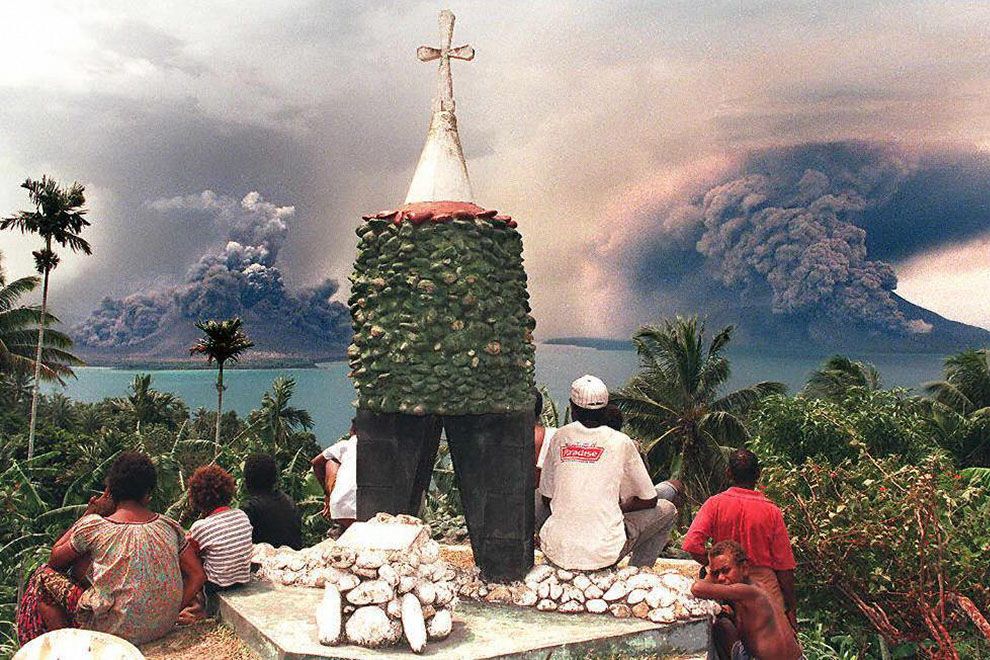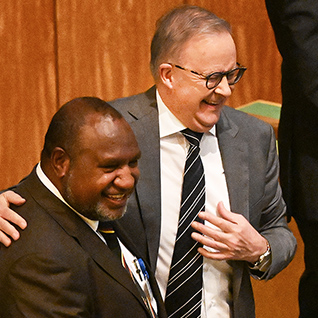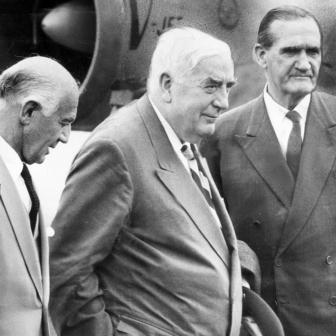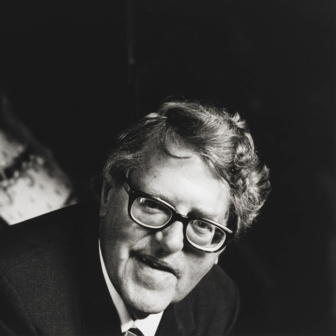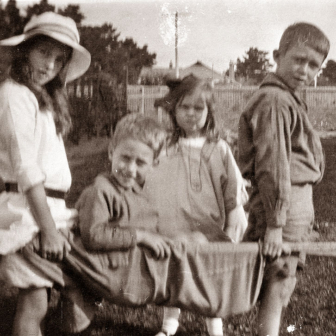A volcanic eruption makes for good footage. More than any other natural disaster, it showcases the awesome force of nature, often without prompting the viewer to dwell on its human consequences. Unlike a storm, an earthquake, a bush fire or a flood, an eruption can appear spectacularly creative rather than merely destructive. And so it was no surprise that when Mount Tavurvur, on the Gazelle Peninsula in Papua New Guinea’s New Britain, began billowing molten rock, ash and smoke in late August, it was reported around the world.
Much of the reporting, particularly outside Papua New Guinea, emphasised the potential for large-scale destruction. At close quarters, however, the eruption seemed less catastrophic than it appeared on television and in newspapers. Some villagers living downwind from Tavurvur lost their food gardens and had to leave their homes, but the town of Rabaul, at the foot of the mountain, was not evacuated. Most residents are accustomed to the volcano’s violent rumblings.
Tavurvur is not strictly a volcano in its own right, but a cone formed by vents of the Rabaul Volcano, which is part of the Pacific Ring of Fire, along which two-thirds of the earth’s 1300 visible volcanoes are located. When the last major eruption of the Rabaul Volcano began – twenty years ago, on 19 September 1994 – vents were active in two locations: at Tavurvur, which lies about four kilometres to the southeast of the centre of Rabaul, and at Kalamanagunan (or Mount Vulcan), eight kilometres south of the town. Kalamanagunan, more than 200 metres high, was formed by an earlier eruption.
Until late last month, the twentieth anniversary of the 1994 eruption was bound to be overshadowed by another event: the commemoration on 11 September of the one-hundredth anniversary of the so-called Battle of Bitapaka, where an Australian expeditionary force overcame German resistance to seize control of the Gazelle Peninsula, the economic and political heart of German New Guinea. The renewed activities of the volcano, called kaia by the local Tolai people, has refocused attention on the catastrophic eruption twenty years ago.
Compared to that previous eruption, the current volcanic activity at the edge of the Rabaul caldera is comparatively benign. The 1994 event was big, both in geological terms and in terms of the impact it had on the local population. Some 80,000 people were displaced, and if that figure is used as a yardstick, the Rabaul eruption of 1994 was the most significant volcanic disaster in the South Pacific in at least one hundred years. It led to the destruction of most of Rabaul, a bustling port town and the political and commercial powerhouse of the New Guinea Islands region.
But the 1994 catastrophe was remarkable not just for its sheer size. It also caused relatively few casualties; it displaced Rabaul; and it led to a forced exodus of people characterised as vaira, or foreigners.
The Rabaul Volcano’s last major eruption had occurred in 1937. It began on 28 May through a vent on the western side of Rabaul Harbour, lasted only four days and created Kalamanagunan. At least 507 people, about half of them from two Tolai villages close to the new mountain, Tavana and Valaur, died in the eruption. Rabaul, which was then the administrative capital of the Territory of New Guinea, held by Australia under a League of Nations mandate, received only moderate ash fall and escaped major damage.
Between 1983 and 1984, increased seismic activity – including 1717 earthquakes in a single day – suggested that another eruption was imminent. The authorities issued a stage two alert, which meant that an eruption was thought to be only “months to weeks” away. On 25 January 1984, the Post-Courier, one of Papua New Guinea’s dailies, announced on its front page: “Big Eruption Soon.” A month later, the cover of Australia’s Bulletin magazine depicted an erupting volcano under the heading, “Rabaul’s Killer Volcano.” Seven thousand of Rabaul’s residents were sufficiently worried about their safety to leave the town. But by 1985, the seismic activity had subsided, and life in Rabaul and its hinterland returned to normal. The thirteen month emergency had come at a huge cost to the local economy, however, and long-time Rabaul residents took two lessons from it: that the volcanologists, who staffed an observatory overlooking Mount Tavurvur, were not particularly good at predicting an eruption, and that evacuation ought to be only a measure of last resort.
Although there were fewer earthquakes after 1985, the scientists working at the Rabaul Volcano Observatory, or RVO, knew that the Rabaul Volcano would erupt sooner rather than later. The last major eruption before 1937 had been in 1878; if the volcano’s apparently cyclical behaviour continued, another eruption would occur in the mid 1990s.
Two major earthquakes – in such close succession that they were experienced as one – shook the northeastern Gazelle Peninsula in the early morning of Sunday 18 September. After a deceptive twelve-hour lull, seismic activity increased significantly from mid-afternoon. Shortly after six o’clock, as night fell, the Provincial Disaster Committee, on advice from the RVO, issued a stage two alert, which was broadcast on the 6.30 pm national news. Throughout the evening, the local radio station, Radio East New Britain, relayed an appeal by the disaster committee for residents to remain calm and stay put.
By then, though, many of Radio East New Britain’s listeners were on the run. In villages surrounding Rabaul, elders counselled people to evacuate. The spectacle of thousands of villagers passing through Rabaul on their way to safety alerted town residents. At around 1.00 am, the volcanologists advised the disaster committee to declare a stage three alert, which assumed that an eruption was “weeks to days” away. News of the impending change in the alert was broadcast by Radio Australia and picked up by listeners in East New Britain. The disaster committee decided to delay a declaration until first daylight, and set about organising the evacuation of Rabaul and advising airlines to withdraw their planes from Rabaul airport, situated at the foot of Tavurvur. The highly unusual roar of planes taking off in the middle of the night was perceived by many in Rabaul and nearby villages as an indication that something was seriously amiss and that the kaia was about to come alive.
At 6.06 am on Monday morning Tavurvur erupted. Seventy-one minutes later, a new vent opened on the northeastern flank of Kalamanagunan. A pilot flying over the area later that morning estimated its eruption column to be more than fifteen kilometres high.
By the time Tavurvur and Kalamangunan began spewing lava, rocks, ash and smoke, most of Rabaul and all the villages that had suffered in the 1937 eruption were deserted. A few people remained on the island of Matupit, just opposite Tavurvur. In the early morning, they saw the ash plume rising out of Tavurvur and heard the local radio announcer, cocooned in his soundproof studio on the outskirts of Rabaul and oblivious to what was happening outside, exhort his listeners on behalf of the Provincial Disaster Committee not to panic or flee.
Papua New Guinea’s last major eruption had occurred in 1951 at Mount Lamington in Papua. Despite a sparser population than on the Gazelle Peninsula, approximately 3000 lives were lost. Remarkably, only five deaths directly resulted from the 1994 eruptions, four of them in Rabaul.
Town residents and Tolai villagers didn’t wait for the local authorities to tell them to evacuate; they moved to safety when it was still possible to leave. None of the villagers living adjacent to Kalamanagunan would have survived if they had remained; their houses were buried under metres of mud. Because of a shortage of transport, people broke into the Department of Works pool and commandeered dozens of government vehicles to ferry residents to safety. The fact that almost 20,000 Rabaul residents and tens of thousands of villagers evacuated without major incident, in the dark and on roads that could be hazardous at the best of times, was miraculous.
Afterwards, the provincial authorities tried to take credit for the smooth evacuation. And it may be that an official order to evacuate would have triggered a panic. But Rabaul residents and Tolai villagers, rather than RVO scientists and the disaster committee, knew when it was time to leave, and accurately predicted that a major disaster was only hours away.
One explanation gave credit to local villagers who, it was said, observed natural warnings that an eruption was imminent. While people certainly identified such signs (the barking of dogs or the strange behaviour of birds, for example) retrospectively, I am not aware of more than isolated cases of people leaving their homes after observing such signs rather than because of the earthquakes on the day before the eruption. Tolai people who had witnessed the 1937 eruption recognised that these tremors were very similar to those that preceded the earlier eruption, and urged their fellow villagers to heed the warning.
Rabaul, nestled between a natural harbour and the volcano’s northern caldera wall, was founded by German colonial authorities in the early twentieth century and became their administrative headquarters. When Australia became the colonial power it retained Rabaul as the seat of government. After the 1937 eruption, a report commissioned by the Australian government recommended that the administrative centre should be moved and Rabaul, with its excellent port facilities, retained as a commercial hub. When the volcano remained quiet after the end of the Pacific war (which had all but wiped out most of Rabaul), however, the Australian colonial authorities failed to act on that report.
Rabaul suffered significant damage in 1994 – not so much as a direct consequence of the eruption, but because looters had almost free reign once the town had been abandoned by its residents. Initially, the police even condoned some of the looting. “I gave a certain instruction then,” the regional police commander recalled, “that if people are going for food, let them loot.”
Much of the looting was done by young Tolai men, but other sections of the population, including expatriates, were also implicated. Once the contents of buildings had been removed or vandalised, the houses themselves became targets. Looters took everything that could be reused as building material (and a lot that could not be put to any use), from louvre blades to sheets of fibro. And the looting was not confined to private houses and businesses, extending also to government buildings, including schools. It affected not only Rabaul but also surrounding villages, where school buildings were vandalised.
The smooth evacuation had been a testament to the ability of town residents and local villagers to organise themselves. Society was functioning, it seemed, even with minimal government intervention. But the post-eruption destruction indicated the opposite: a dysfunctional society in which many were no longer able to distinguish right from wrong or recognise that communal facilities belonged to everyone and needed to be cared for by everyone.
We remember the 1994 eruption because it resulted in the destruction of what was considered one of the most beautiful towns in the South Pacific. Probably more so than any other town in Papua New Guinea, Rabaul was held in great affection by the people who lived there as well as by people living in surrounding villages. “Rabaul yu swit moa yet… maski mi go na mi tingim yu yet” (Rabaul, you are so sweet… even if I left I would still think of you), the Papua New Guinean band Barike sang in their 1994 hit “Rabaul Town.” Yet that affection did not translate into an effective resolve to protect the town – by clearing the roofs of buildings from ash to stop them from collapsing, and by stopping the looters.
Unlike after 1945, Rabaul did not have a phoenix-like rebirth following the 1994 eruption. The provincial authorities moved to nearby Kokopo (once called Herbertshöhe, and the seat of the German colonial government before the establishment of Rabaul) and the airport was moved to the east of the Gazelle Peninsula. Much of Rabaul has been rebuilt, but the pre-1994 Rabaul has gone.
The northeastern Gazelle Peninsula is home to the Tolai people, one of Papua New Guinea’s most prominent and influential ethnic groups. Tolai also lived in Rabaul, but Rabaul had never been a Tolai town. It was home to Chinese, Europeans, Australians and vaira, “strangers,” the term Tolai use to refer to Papua New Guineans from other parts of the country. For more than a hundred years they had come to East New Britain to work, or to stay with relatives who were working. Most of them lived either in Rabaul or on one of the plantations. They had not all come voluntarily: many vaira were cajoled into working in or near Rabaul during the colonial era. Those who had arrived more recently to work on copra and cocoa plantations sometimes regretted having come, but did not have enough money to pay for their trip home.
Tolai were ambivalent about the vaira living in their midst. Demands to repatriate all unemployed vaira were popular and resurfaced regularly in the lead-ups to elections. Tolai-dominated provincial governments tried to restrict squatting by vaira in Rabaul. In the months preceding the 1994 eruption, the government ordered the eviction of many squatters and the bulldozing of their settlements. Squatters were held responsible for any lawlessness in town.
Tensions between vaira and Tolai go back a long way. Conflicts could be triggered by Tolai women eloping with a vaira, vaira squatting on Tolai land, or vaira helping themselves to food grown in Tolai gardens. But the relationship between Tolai and vaira was also marked by a successful symbiosis that contributed to the prosperity of the Gazelle Peninsula and to Rabaul’s vibrancy. For many Tolai, the sale of garden produce and betel nuts has long been an important source of cash income. And as most vaira living in town had insufficient garden land to grow their own food, Rabaul’s substantial vaira population accounted for a large proportion of customers at the Rabaul market.
After the eruption, the non-Tolai residents of the area affected by the volcano were expected to go “home.” Some policy-makers in East New Britain thought that the repatriation of vaira was the one positive result of the eruption. To prevent squatters from moving back into town, they had been quick to flatten what remained of the squatter settlements in Rabaul after the eruption. Police were instructed to evict squatters from derelict houses in Rabaul. They were supported by a neighbourhood watch committee, which patrolled the town at night and reported people occupying abandoned buildings.
Chartered ships and planes took the vaira to their home provinces. For those who had been in Rabaul for only a few years and had lost their houses and their jobs, repatriation seemed a sensible enough solution. It provided a welcome opportunity for plantation labourers who did not have much of a stake in East New Britain. But many of Rabaul’s vaira had known only one home: Rabaul. Their parents or grandparents had migrated to East New Britain more than twenty years earlier and they identified as pikinini bilong Rabaul, Rabaul’s children. They had rarely been to the places they were now told to return to. This was particularly true for the so-called Sepiks, people from East Sepik and Sandaun Provinces in northeastern New Guinea, who formed by far the largest contingent of Rabaul’s vaira.
In October 1994, East Sepik’s premier Alex Anisi addressed the Sepik evacuees at the Kokopo Showground. He promised them free transport back to Wewak, the capital of East Sepik Province, and urged them to make use of the offer. He waved aside questions of how second and third generation Sepiks in Rabaul would settle back “home”: “You will be all right. You will fit in. The important thing is you must come home. We will sort out those things at home.” When the ships from Rabaul arrived in Wewak, trucks and buses provided by the local authorities took the evacuees straight to various government and mission stations. The authorities in Wewak did not provide any assistance to the repatriated Sepiks beyond paying for their transport. Generally, people in East Sepik Province were not overly enthusiastic about those people from Rabaul suddenly turning up on their doorsteps.
Returning to their ancestral lands in mainland New Guinea proved to be a disappointment for many of the repatriated Sepiks. The land they once owned had long been taken over by others. They were made welcome but not for long. “Why should we give you food or let you sleep in our house?,” their relatives often asked. “After all, you never thought of us when you lived in comfort in Rabaul.” Because they came from Rabaul, the new arrivals were expected to have money. Sometimes, people in the village would call them vaira or say: “You Tolai better go back to where you have come from.” “Mipela hangamap nating tasol” – “we are lost” – many of them summed up their situation after having returned “home.”
Papua New Guineans have had their share of terrible natural disasters. The 1998 earthquake and tsunami near Aitape in northeastern New Guinea, for instance, claimed more than 2000 lives, and Cyclone Guba in November 2007 killed more than 200. On 19 September 2014, they won’t think back to the catastrophe of September 1994 with a huge human death toll in mind. But its impact extended far beyond the destruction of infrastructure, buildings and crops.
Tolai will commemorate their resilience. They have learnt to live with a volcano that has barely stopped rumbling during the past twenty years. They have rebuilt their society, and extended its reach beyond the territory they traditionally occupied, when villagers from communities close to the volcano were resettled on land in the south of the Gazelle Peninsula.
On 19 September, people across Papua New Guinea will mourn the passing of the old Rabaul. But Rabaul was more than scenic Mango Avenue, the various clubs and hotels, or its sprawling market. Rabaul was living proof that a polyglot multicultural Papua New Guinean town can coexist successfully with ethnically homogenous and prosperous villages. It was home to vaira who weren’t born in Rabaul, and to Tolai who did not even live there. The spectacular footage of lava and ash plumes may make us forget that a volcanic eruption is not just a natural disaster. •
